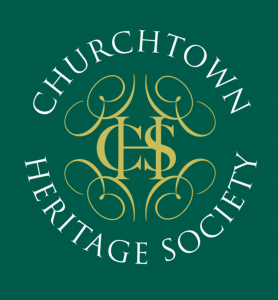CHURCHTOWN SCHOOL IN THE 1920s
By William O’Flynn, Rath, Churchtown
When I started school in 1923 at five years old, everything was very primitive compared to now. The old school had two rooms, the boys in the lower one and the girls upstairs. We had four teachers, two men and two women.
Mr. Thomas Tierney was our principal, who was a very good teacher, but as Goldsmith said, stern to view and you see the day’s disaster in his morning face. The school itself was a rather dreary place, painted a dull green many years before I started, and never repainted during my nine years there. There were two grates and there was one used during the winter at the assistant’s end, but there was never a fire lit at Mr. Tierney’s end. His desk was on a slightly raised platform and he sat there in frost and snow, quite impervious to both.
He always sat with his legs crossed with an ash plant between them. Each pupil came in with his home exercises, mainly arithmetic and compositions with a little history, and if he thought you took any shortcuts, the stick came into play very fast indeed. Strange to say, even though the stick was feared, his sarcasm was feared more, and I saw many pupils immune to a few slaps break down in tears if they were the target of his sarcastic remarks. Tables and mental arithmetic were top priority with him, and he took up most of the day with catechism of course.
The roll call, at that time printed on a slate, was approximately 110 boys and about 120 girls. This meant that each teacher had about 50 pupils each, so there were often two or more classes pooled together, especially for geography where you stood around a very large map, of which there were about four, while Mr. Tierney slowed you the different countries and then the different industries.
He was Principal there for many years before I went, and for about nine years after I left. He never taught Irish which was left to the assistant, who was Mr. Motherway, when I went there first, and who came each day on a motorbike, which was a great novelty for the pupils.
He was replaced by Mr. Wall who, in later years became Principal. His subjects were mostly Irish, nature studies which he loved, and poetry and singing. He loved to have his pupils bring in the wild flowers and frogspawn and tadpoles in jars. He also loved teaching us Thomas Moore melodies.
I have to mention the complete lack of facilities, no toilet, no hot water, and plenty of mice and draughts. In our young day we had a nice jovial curate, Rev. Fr. Ellard, who came in often. He enjoyed drawing a man’s face on the blackboard, and then blindfolding us and trying to draw a cigarette in his mouth. The winner got a penny, which was a fortune in those times.
Our Parish Priest, Fr. Foley, also called and he had one song that he always sang. The Bonny Bonny Banks of Loch Loman. We got six weeks holidays in the Summer, three weeks at Christmas, and two weeks at Easter, but no other days off apart from Church holidays. There were about eight long seats in the school, so many had to stand, and when doing long multiplication, or long division, we stood back to back by the walls.
As there was no prospect of secondary schooling for 90% of the pupils then, we had to do our best in the few classes in primary, as we were always advised by our teacher.
When Mr. Wall first came to Churchtown, he was lodging at Costello’s and his future wife was living next door. Sometime later they started going out together. At that time there was a lower walk in Burton Park with a garden seat. One evening nine or ten of us were playing in the next field and we saw them coming. We hid in the bushes and they sat down on the seat. After a while he put his arm around her and gave her a hug. This was greeted with a cheer which brought them apart like an atomic bomb. He chased us but caught no one. He knew all of us, and the following day we were all caned and put kneeling on the paving stones for half an hour. After that we lost interest in romantic affairs.
In those days the majority of children went barefoot to school for nine months of the year as the money was very scarce. As there was no playground then, boys and girls played on the road, and the four teachers stood by the wall for a chat.
As there were no motorcars we were quite safe on the road. Finally, I would like to pay a tribute to our teachers, especially to Mr. Thomas Tierney who was really dedicated and produced many talented pupils who had no secondary education, such as the late Jim McCarthy R.I.P. , a wonderful local historian, who left school in 1933, one year after myself.




